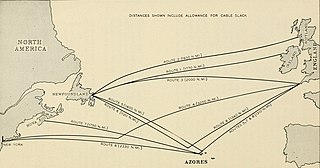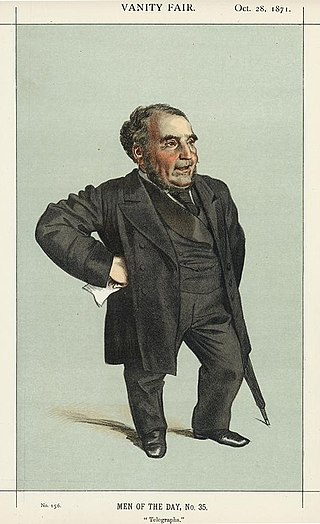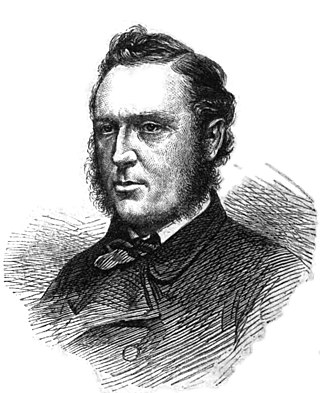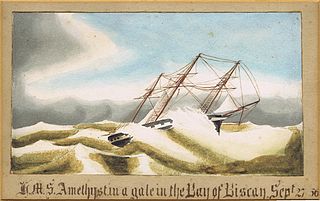
TAT-1 was the first submarine transatlantic telephone cable system. It was laid between Kerrera, Oban, Scotland and Clarenville, Newfoundland. Two cables were laid between 1955 and 1956 with one cable for each direction. It was inaugurated on September 25, 1956. The cable was able to carry 35 simultaneous telephone calls. A 36th channel was used to carry up to 22 telegraph lines.
A transatlantic telecommunications cable is a submarine communications cable connecting one side of the Atlantic Ocean to the other. In the 19th and early 20th centuries, each cable was a single wire. After mid-century, coaxial cable came into use, with amplifiers. Late in the 20th century, all cables installed used optical fiber as well as optical amplifiers, because distances range thousands of kilometers.

Cyrus West Field was an American businessman and financier who, along with other entrepreneurs, created the Atlantic Telegraph Company and laid the first telegraph cable across the Atlantic Ocean in 1858.

Transatlantic telegraph cables were undersea cables running under the Atlantic Ocean for telegraph communications. Telegraphy is an obsolete form of communication, and the cables have long since been decommissioned, but telephone and data are still carried on other transatlantic telecommunications cables.

Valentia Island is one of Ireland's most westerly points. It lies off the Iveragh Peninsula in the southwest of County Kerry. It is linked to the mainland by the Maurice O'Neill Memorial Bridge at Portmagee. A car ferry also departs from Reenard Point to Knightstown, the island's main settlement, from April to October. Another, smaller village named Chapeltown sits at roughly the midpoint of the island, three kilometres from the bridge. Valentia Island's permanent population is 658. It is about 11 kilometres long by almost three kilometres wide, making it the fifth-biggest island off the Irish coast.

Waterville, historically known as Coirean, is a village in County Kerry, Ireland, on the Iveragh Peninsula. The town is sited on a narrow isthmus, with Lough Currane on the east side of the town, and Ballinskelligs Bay on the west, and the Currane River connecting the two.

The All Red Line was a system of electrical telegraphs that linked much of the British Empire. It was inaugurated on 31 October 1902. The informal name derives from the common practice of colouring the territory of the British Empire red or pink on political maps.

A cable layer or cable ship is a deep-sea vessel designed and used to lay underwater cables for telecommunications, for electric power transmission, military, or other purposes. Cable ships are distinguished by large cable sheaves for guiding cable over bow or stern or both. Bow sheaves, some very large, were characteristic of all cable ships in the past, but newer ships are tending toward having stern sheaves only, as seen in the photo of CS Cable Innovator at the Port of Astoria on this page. The names of cable ships are often preceded by "C.S." as in CS Long Lines.

Edward Orange Wildman Whitehouse was an English surgeon by profession and an electrical experimenter by avocation. He was recruited by entrepreneur Cyrus West Field as Chief Electrician to work on the pioneering endeavour to lay the first transatlantic telegraph cable for the Atlantic Telegraph Company between western Ireland to eastern Newfoundland. This pioneering project of the Victorian era began in 1854 and was completed in 1858; however the cable functioned for only three weeks. While Whitehouse sent the first telegraph communications on 16 August 1858 to the United States of America, he was ultimately held responsible for the undersea cable failure after he applied higher voltages in an effort to boost declining signals.

Heart's Content is an incorporated town in Trinity Bay on the Bay de Verde Peninsula of Newfoundland and Labrador, Canada.

Sir Charles Tilston Bright was a British electrical engineer who oversaw the laying of the first transatlantic telegraph cable in 1858, for which work he was knighted.

Sir John Pender KCMG GCMG FSA FRSE was a Scottish submarine communications cable pioneer and politician.

Robert Charles Halpin, Master Mariner, was an Irish sea captain. He captained the Brunel-designed steamship SS Great Eastern which laid transoceanic telegraph cables. A successful pioneer of this work, he earned the nickname "Mr Cable".

The Russian–American Telegraph, also known as the Western Union Telegraph Expedition and the Collins Overland Telegraph, was an attempt by the Western Union Telegraph Company from 1865 to 1867 to lay a telegraph line from San Francisco, California, to Moscow, Russia.
SS Hibernia was a steamship built in the shipyards Palmer Brothers & Company of Jarrow, County Durham, England, in 1861. The ship was made of iron, including three decks and six bulkheads. She was 360 feet (110 m) long and 40 feet (12 m) wide with a hold depth of 29 feet 1 inch (8.86 m). She was 2,164 net tonnes with a thrust of 320 horsepower (240 kW).
William Thomas Henley (1814–1882) was a pioneer in the manufacture of telegraph cables. He was working as a porter in Cheapside in 1830, leaving after disputes with his employer, and working at the St Katherine Docks for six years. During those years he was determined to learn a trade and used money from an aunt to purchase a lathe, vice and lumber with which he made a work bench. With those tools he taught himself to turn wood and brass and began to experiment, including with electricity.

Sir James Anderson (1824–1893) captained SS Great Eastern on the laying of the Transatlantic telegraph cable in 1865 and 1866.

HMS Iris was a 26-gun sixth-rate frigate launched on 14 July 1840 from Devonport Dockyard. She spent some time with the West Africa Squadron suppressing the slave trade and later with the East Indies Station was involved in operations in Borneo. Iris was the first flagship of the Australia Station between 1859 and 1861 during which time she participated in the First Taranaki War. In 1864 she was extensively modified to allow her to ferry transatlantic telegraph cable to the cable-laying ship Great Eastern. She was decommissioned and sold off in 1869.

Sir Samuel Canning (1823–1908) was an English pioneer of submarine telegraphy.

HMS Amethyst was a gaff rigged three mast sailing boat. She was a Spartan-class 26-gun sixth rate launched in 1844 and sold in 1869 for use as a cable vessel.




















